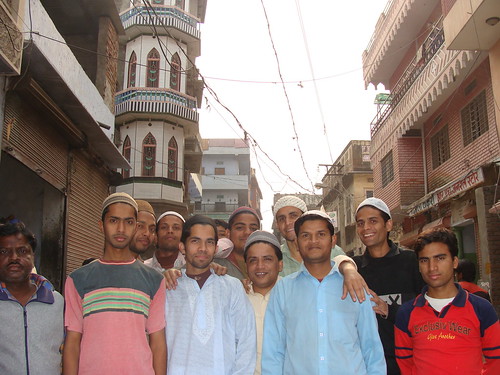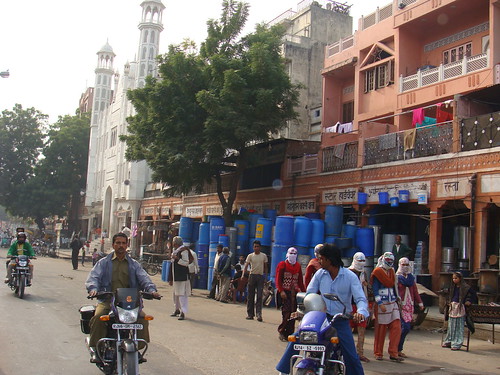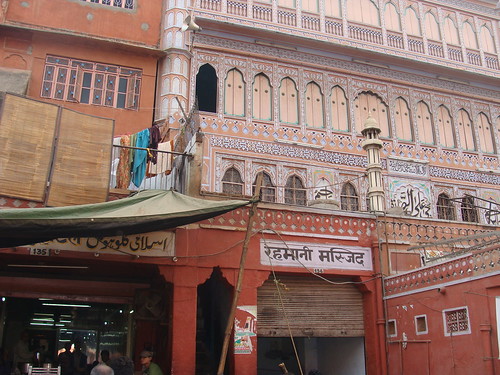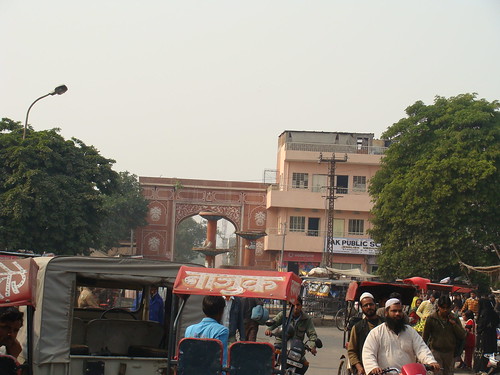Series on Jaipur – Part 2
By Mumtaz Alam Falahi, TwoCircles.net,
Not only that they are backward educationally and economically, over five lakh population of the Muslim community in the Pink City is also fragmented in castes and has been living in ghettos for about two decades. Of late, however, they have started taking notice of their own sordid state – and now are sending children to schools, opening their own schools and technical institutes and getting politically active, a bid to swim along the mainstream.
There are about one dozen thickly-populated Muslim pockets – in popular terms, ghettos – in Jaipur – the capital city of Rajasthan.

Char Darwaza area
Ghettoized
“They are living in separate localities. Jalupura, Hameed Nagar, Chandpur, Topkhana, these are pure Muslim areas. Non-Muslims areas are separate,” says Muhammad Yunus, Jalupara resident and a school director. “The trend started after 1991. Before that they would live in mixed colonies,” he adds.
“There are three types of areas: Muslim dominated with 1 or 2 % others, Hindu dominated with 1 or 2 % others and mixed areas,” says Mufti Amjad, Imam of Jama Masjid, Jaipur. Some Muslim dominated areas include Ramnagar, Jalupura and Bhatta Basti (Shastri Nagar).
Explaining when and why Muslims started to live in ghettos, Kavita Srivastava, General Secretary, People’s Union for Civil Liberties, says: “In mid-eighties, Muslims began moving to mixed colonies where people from different faiths were living. But post-Babri demolition and communal riots, it was very tragic when people left those homes and came back into those ghettos.”
Agrees Advocate Abdul Qayyum Akhtar, General Secretary, All India Milli Council.
“Muslims have been living in ghettos in Jaipur for years together. They are living in the old city areas of thick density. They are not coming out as they do not find any incentive. Until their educational and economic condition improves, how can they come out of the ghettos? If the new generation gets education and their economic condition improves they will definitely come out,” Adv Akhtar says.

Muslim dominated Ram Nagar youth
Fragmented in castes
Another dimension of the local Muslim community is castes. Virtually they are fragmented in castes. There are 63 Muslim castes or sub-castes only in the OBC category, leave alone the unreserved or generals.
“Structure of Jaipur is caste based. Caste works here as a unit,” says Nizamuddin, Secretary, Ahangran Girls College in Ghat Gate area, another Muslim dominated pocket. Ahangran (lohar) is a Muslim caste and comes under OBC. In Jaipur the total population of Ahangran is 15000, about half of them (8000) in Ghat Gate area.
Asked about the socio-economic condition of Muslims particularly Dalit Muslims in Jaipur, Abdul Lateef, President, Dalit-Muslim Ekta Manch, and state secretary, All India Milli Council says: “Like rest of the Muslim community, the educational and economic condition of Dalit Muslims, though in good number here, is very poor. As they are very backward in education their presence is negligible in job and government services.” They are also not getting much from the OBC quota as Jats are getting the lion’s share.

Muslim dominated Ghat Gate area
“There are 63 Muslim castes in OBC but they are not getting much benefit from the quota as Jats, the dominant community, get 90% of the OBC quota,” says Abdul Lateef who comes from the Mansoori caste that is also in OBC category. “Another reason is that Muslims are either unaware of their rights or do not know how to take their rights. We are launching awareness campaign so that our community gets aware of their rights and means to get them,” Abdul Lateef says.
As there are 63 Muslim groups in OBC, are you demanding for quota within quota?
“Yes, we have been demanding for quota within quota for several years. Now the government has agreed to allocate 15% of 27% OBC quota for Muslims. We hope this will benefit the community,” informs Abdul Lateef.

Nizamuddin before Ahangaran Girls College
Ray of hope
Of late, however, the Muslim community, though still fragmented and ghettoized, has started to send signals of ray of hope. They are making progress in education and getting active politically. They are also getting closer to religion.
“The Muslim community is now luckily coming out of the leadership of only few religious leaders. They are defining themselves through the social and economic issues. They are also defining themselves through other political issues rather than simply identity issues. For years they were stuck with identity issues. True, it is important, but they can be taken up along with socio-economic and political issues,” says Kavita Srivastava, General Secretary, PUCL.

“The position of Muslims both in modern and religious education has improved. People are sending children to schools and madrasas,” says Mufti Amjad.
“Ahangar community has opened schools from primary to college level, for both boys and girls. Rahmani community has also done a lot for education of the community. Jamia Hidayat gives both religious and modern education including technical education,” Mufti Amjad informs.
Abdul Lateef himself is running three technical institutes for the community. Besides, to bring Dalit Hindus and Muslims together, he has set up Dalit-Muslim Ekta Manch.
“We formed the organization this year. The main reason behind the formation was to bring the Hindu Dalits and backward classes closer to the Muslim community. Rajasthan has often faced communal riots wherein the Hindus from the lower strata have been used by Brahman and Baniya communities. As they are poor like us we decided to come closer to share our grief and happiness in order to strengthen communal harmony and brotherhood. So that communal forces could not use them. Dalit Hindus constitute 6% of the population in Jaipur,” says Abdul Lateef.
On the other hand, All India Milli Council last year launched a political awareness campaigns in Rajasthan. On the impact of political awareness campaign by All India Milli Council around the last Lok Sabha elections, Adv Abdul Qayyum Akhtar says: “The campaign had positive results not only in general elections but also in assembly as well as local body elections. People came out and tried to polarize the community in favor of the Congress only for a secular and democratic government.”
“But this is not enough. We have to become a force so that the Congress could realize that the support of Muslims is key to their victory. The hike in percentage of Muslim voting was the sole reason for the Congress to win the elections,” Adv Akhtar says.
Along with politics, the Muslim community is also getting closer to religion.

Muslim dominated Ram Nagar area
“After two big Tablighi Ijtemas here, Muslims have come closer to religion – small mosques have been expanded, new mosques have come up in new mohallas. Mosques are now populated. People now listen to sermons,” says Mufti Amjad.
“People are now making their children Hafiz and Alim. There are 20-25 alims in Jaipur. They include 10-12 muftis. They are native of Jaipur.” Mufti Amjad informs adding: “There are 300 mosques in Jaipur. Earlier it was difficult to find a Hafiz. Now the Hafiz has to struggle to find vacancy to recite Quran duing Ramazan. There are so many local Hafizs now.”
